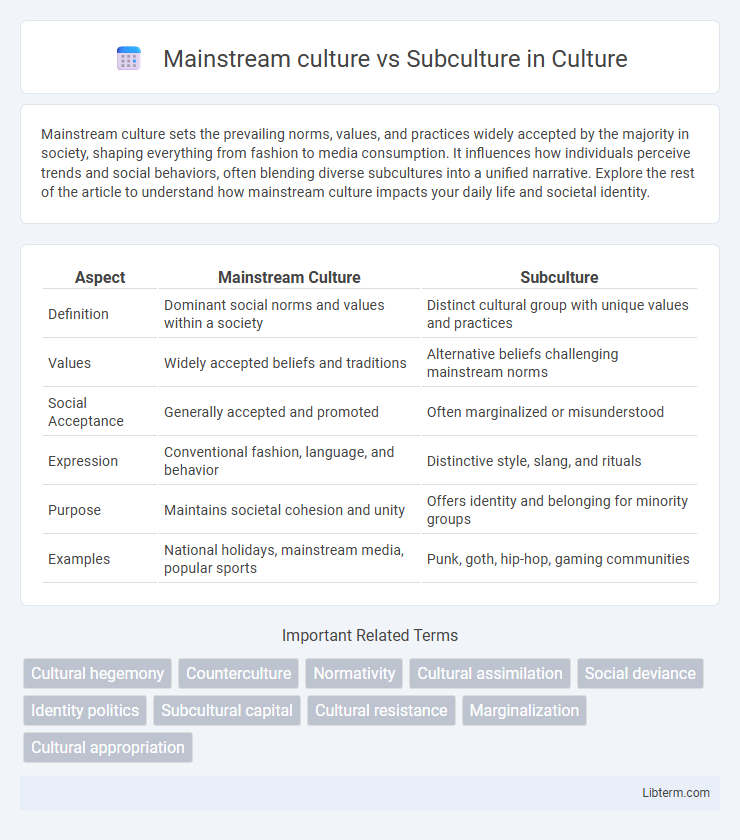Mainstream culture sets the prevailing norms, values, and practices widely accepted by the majority in society, shaping everything from fashion to media consumption. It influences how individuals perceive trends and social behaviors, often blending diverse subcultures into a unified narrative. Explore the rest of the article to understand how mainstream culture impacts your daily life and societal identity.
Table of Comparison
| Aspect | Mainstream Culture | Subculture |
|---|---|---|
| Definition | Dominant social norms and values within a society | Distinct cultural group with unique values and practices |
| Values | Widely accepted beliefs and traditions | Alternative beliefs challenging mainstream norms |
| Social Acceptance | Generally accepted and promoted | Often marginalized or misunderstood |
| Expression | Conventional fashion, language, and behavior | Distinctive style, slang, and rituals |
| Purpose | Maintains societal cohesion and unity | Offers identity and belonging for minority groups |
| Examples | National holidays, mainstream media, popular sports | Punk, goth, hip-hop, gaming communities |
Defining Mainstream Culture
Mainstream culture represents the dominant set of values, beliefs, and practices widely accepted and practiced by the majority within a society. It encompasses popular media, language, norms, and consumer behaviors that shape collective identity and societal cohesion. This cultural mainstream often influences legal systems, educational curricula, and institutional frameworks, establishing a shared reference point for social interaction and cultural legitimacy.
Understanding Subculture
Subculture represents a distinct group within mainstream culture, characterized by unique values, norms, and behaviors that differentiate its members from the dominant societal practices. Understanding subculture involves analyzing its symbols, language, fashion, and rituals, which serve as markers of identity and social cohesion. This exploration reveals how subcultures challenge or complement mainstream cultural narratives, offering alternative perspectives and fostering diversity within society.
Historical Evolution of Mainstream and Subcultures
Mainstream culture has evolved through dominant social, political, and economic forces shaping collective values, norms, and institutions over centuries, often reflecting majority power structures. Subcultures emerged as distinct groups with unique styles, beliefs, and practices challenging or diverging from mainstream norms, frequently arising during periods of social change such as the 1960s counterculture movement or the punk scenes of the 1970s. The dynamic interaction between mainstream culture and subcultures illustrates ongoing cultural negotiation, resistance, and assimilation throughout history.
Core Differences Between Mainstream and Subculture
Mainstream culture represents the dominant, widely accepted societal norms, values, and practices shared by the majority population, while subculture consists of smaller groups with distinctive beliefs, behaviors, and interests that deviate from mainstream conventions. Core differences include identity formation, where mainstream culture promotes conformity and common social norms, whereas subcultures emphasize uniqueness and alternative lifestyles. Additionally, mainstream culture often receives institutional support and media representation, contrasting with subcultures that operate more independently and sometimes in opposition to dominant cultural narratives.
The Role of Media in Shaping Culture
Media acts as a powerful agent in defining mainstream culture by amplifying dominant values, norms, and trends through widespread television, social networks, and popular films. Subcultures use alternative media platforms such as niche blogs, podcasts, and underground channels to express distinct identities and resist mainstream narratives. This dynamic interplay influences cultural evolution, as media both reinforces dominant ideologies and provides subcultures with tools to challenge and diversify societal norms.
Influence of Mainstream Culture on Society
Mainstream culture shapes societal norms, values, and behaviors by establishing widely accepted standards through media, education, and institutions. It influences consumer preferences, fashion trends, language, and social practices, creating a cohesive identity across diverse populations. The pervasive reach of mainstream culture can marginalize subcultures, yet it also facilitates cultural exchange and innovation within society.
The Impact of Subcultures on Mainstream Trends
Subcultures significantly influence mainstream culture by introducing innovative fashion, language, and values that eventually become widely adopted. Elements from punk, hip-hop, and goth subcultures have shaped music, clothing, and attitudes within popular culture, reflecting shifts in societal norms. This dynamic fosters cultural diversity and drives continuous evolution within the mainstream, highlighting the importance of subcultural creativity.
Conflict and Coexistence: Mainstream vs. Subculture
Mainstream culture often imposes dominant values and norms that can marginalize subcultures, leading to conflict through social exclusion or stereotyping. Subcultures resist assimilation by expressing alternative lifestyles, languages, or art forms that challenge mainstream narratives and foster identity. Despite tensions, coexistence emerges as subcultures impact mainstream culture through innovation, adoption, and cultural exchange, creating a dynamic interplay between conformity and diversity.
Cultural Appropriation and Authenticity
Mainstream culture often assimilates elements from subcultures, raising critical concerns about cultural appropriation when symbols or practices are unacknowledged or misused outside their original context. Authenticity becomes a pivotal issue for subcultures striving to maintain their distinct identity amid commercialization and dilution by dominant cultural narratives. The tension between preserving genuine cultural expressions and the widespread adoption by mainstream culture underscores ongoing debates about respect, representation, and power dynamics in cultural exchange.
The Future of Mainstream and Subcultures
Mainstream culture is increasingly influenced by digital innovation, driving rapid shifts in global trends and consumer behavior. Subcultures leverage online platforms to expand their reach and influence, fostering niche communities that challenge conventional norms and contribute to cultural diversity. The future of both mainstream and subcultures depends on the dynamic interaction between technology, social values, and the continuous exchange of ideas across different cultural groups.
Mainstream culture Infographic

 libterm.com
libterm.com